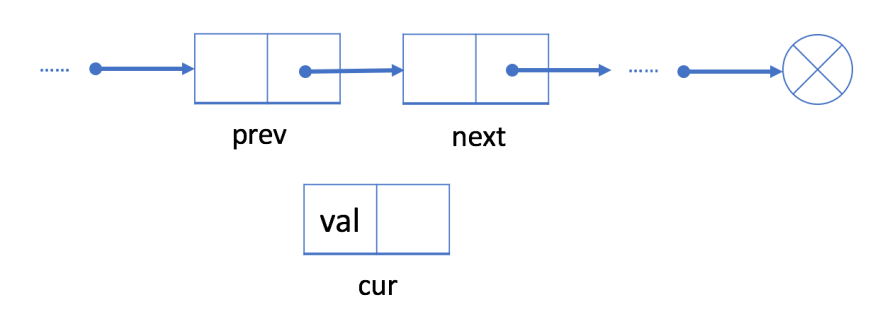My summary of Leet code linked list explore card. Additional information from GeekforGeeks
linear data structure.
Each element in the linked list is a separate object while all the objects are linked together by the reference field in each element.
1. Singly Linked List
Each node in a singly-linked list contains the value & reference field to link to the next node. This allows the singly-linked list organizes all the nodes in a sequence.
Node Strcuture
The first node in linked list is called head node
Head node if typically used to represent the whole list.
Each node in a list consists of at least two parts:
- data
- Pointer / Reference to next node
class LinkedList {
Node head; // head of the list
// constructor
LinkedList() { head = null; }
/* Linked list Node*/
class Node {
int data;
Node next;
// Constructor to create a new node
// Next is by default initialized as null
Node(int d) { data = d; }
}
}
In Java or C#, LinkedList can be represented as a class and a Node as a separate class. The LinkedList class contains a reference of Node class type.
Operations
1. Find
complexity: O(N)
cannot access random element in constant time. to get to i th element must traverse from head to node one by one.
2. Add
2.1. Adding node at random location / after given node
complexity: O(1)
There is no need to move all elements past the inserted element (cur). In this case, prev node is given, just change "next" field.
- check that given node is not null
- initialize node to be inserted
cur
- Link the "next" field of
curto nodenext
- Link the "next" field in
prevtocur
2.2. Adding node at front of Linked List
Since node head is used to represent the entire linked list. We need to
update
headwhen adding new node to beginning of list
- Initialize a new node
cur - Link the new node to our original head node.

- Move head to point to new node


2.3. Adding at end of linked list
complexity: O(N)
must traverse all elements of linked list to find last node
- Create new node
cur - Assign "next" field in
curto null.
- if linked list if empty
curis head node - else, traverse linked list till the last node
tmpis reached (node where "next field is null) - Link "next" field of last node to
tmpto new nodecur
3. Delete
3.1 Delete a given node
time complexity: O(N)
space complexity: O(1)
eg. delete a current node cur
- traverse linked list from head node to find previous node
prev
- Link "next" field in
prevnode to thenextnode
time complexity: O(N)
need to traverse linked list to find the node. time depends on number of nodes in linked list
space complexity: O(1)
need constant space to store pointers.
3.2 Delete head node
time complexity: O(1)
- Assign
headnode asnextnode
3.3 Delete node at end of list
time complexity: O(N)
- traverse through linked list till second last node
previs found - assign the "next" field of
prevtonull
Classic Problems
Cyclic Linked List
Check if linked list is a cycle
1. Hashmap
time complexity: O(N)
space complexity: O(1)
store past nodes in hashmap. check if next node is in the hashmap.
2. Two pointer
time complexity:
space complexity: O(1)
Get a fast runner and slow runner. if linked list is cyclic, fast and slow runner will eventually meet.
fast = node.next.next;
slow = node.next;
//check
if (fast == slow) {
// list is cyclic
}
Reverse Linked List
Reverse a singly linked list
1. Iterative method
time complexity: O(N)
space complexity: O(1)
Iterate through the nodes and move the to the head of the list one by one, until the original head node is the last one.
- original

- move second node to the head

- move last node to the head
 original "head" node's next value is null. Algorithm can stop.
original "head" node's next value is null. Algorithm can stop.
2. Recursive Method
Node reverse(Node head) {
if(head == null) {
return head;
}
// last node or only one node
if(head.next == null) {
return head;
}
Node newHeadNode = reverse(head.next);
// change references for middle chain
// next node after head, put forward and point to head
head.next.next = head;
// head will become tail so just make next null
head.next = null;
// send back new head node in every recursion
return newHeadNode;
}
Time Complexity: O(n)
Space Complexity: O(n)
extar space from implicit stack due to recursion. Recursion can go n-levels deep
2. Doubly Linked list
Each node contains
valuefield,nextreference field &prevreference field
Node Structure
head node represents the entire linked list
class DoublyLinkedList{
DoublyListNode head;
// constructor
DoublyLinkedList() {head = null;}
class DoublyListNode {
int val;
DoublyListNode next, prev;
// constructor
DoublylistNode(int x) {val = x;}
}
}
1. Find
time complexity: O(N)
Cannot access random position in constant time. must tarverse from head to ith node to access it.
2. Add
2.1 Add node after a given node
Time complexity: O(1)
Space complexity: O(1)
- link
cur's "prev" reference field withprev& linkcur's "next" reference field withnext
- link
prev's "next" reference field tocur&next's "prev" reference field tocur
2.2 Add node at head of list
time complexity: O(1)
- Change
curnode's next field to referencefirstnode - Change
firstnode's prev field to referencecur - Change head Node of doubly linked list to
cur
2.3 Add node at end of list
time complexity: O(N)
- Traverse linked list to find the last node of the list
last(we only know head node from Doubly Linked List, must iterate to find the last node) - Change
curnode's prev field to referencelastnode - Change
lastnode's next field to referencecurnode.
3. Delete
time & space complexity: O(1)
Can just link prev node's next field to cur node's prev field.
Can get previous node using
prevfield in doubly linked list
The ability to "go backwards" in doubly liked list means that there is no need to traverse linked list (O(N)) to get prev node
3.1 Delete a given node
time complexity: O(1)
space complexity: O(1)
- link
23's next field to15 - link
15's prev field to23
3.2 Delete head node
time complexity: O(1)
space complexity: O(N)
- Change head node of Doubly Linked List to
secondnode - Change
secondnode's prev field to null
3.3 Delete last node
time complexity: O(N)
space complexity: O(1)
still need to traverse to the end of linked list to get last node. So time complexity is O(N)
- traverse linked list to find the last node
end - Go backwards 1 step to find node
second last - Change
second last's next reference field to point tonull.
Doubly VS Singly Linked List
taken from GeeksforGeeks
Advantage
1. bi-direction traverse
DLL can traverse both forward & backeard
2. delete more efficient
delete operation in DLL more efficient if pointer to node to be deleted is given
3. insert before given node
In singly linked list, to delete node, pointer to previous node is needed. So must traverse list.
Disadvantage
1. extra space
Every node of DLL requires extra space for previous pointer.
2. operations
All operations require previous node to be mantained. May require extra steps as compared to singly linked list.
Comparison with array
Advantage
1. Dynamic Size
Array size cannot be changed. So upper limit of elements must be known before creation.
Allocation memory for array is equal to upper limit irrespective of usage.
2. Better Complexity in insertion / deletion
Expensive because room must be created & existing items must be shifted.
Eg. sorted array
int[] id = new int[]{1000, 1010, 1050, 2000, 2040}
To insert new id (1005) & mantain order.
all elemented after 1000 must be moved
To delete id (1010), all elements after 1010 must be moved forward.
Disadvantage
1. Random access not allowed
Cannot be binary search with default implementation.
Binary search must find middle element then move left or right. in array its O(1) (get array.length/2) but in linked list, size is dynamic and must traverse elements to find length + get to middle element.
2. Extra memory space
For each element / node in Linked list, a pointer is required.
Each linked list Node must store its value + pointer to next node.
3. Not cache friendly.
Array is cache friendly since elements are placed right next to each other. however, elements of linked-list can be placed anywhere in the memory.
Therefore, iterating through linked-list will cause more cache miss since we cannot make use of locality of reference.
(Check out Cache operation - spatial locality. In Spatial Locality, memory in nearby locations are cached. different from temporal locality where actual memory is cached (often with a TTL - Time to live))
Summary
- cannot access node in
O(1)time - add node after given node / head in
O(1)time - delete first head in
O(1)time - deleting given node
4.1 singly linked list -> delete given in
O(N)time, needO(N)time to findprevnode 4.2 doubly linked list -> delete given node inO(1)time
Linked list better choice for adding / deleting nodes frequently. Array better if accessing random elements / nodes frequently.










Top comments (0)